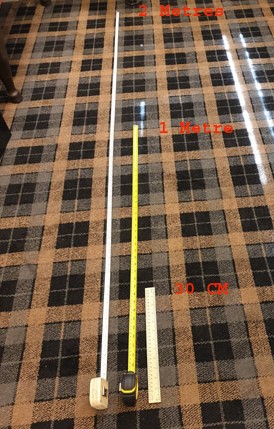 Coronavirus: What is 2 metres?
Coronavirus: What is 2 metres?
 It seems rather surreal to be writing an article about what length of distance constitutes two metres. However, during the current epoch of the coronavirus outbreak an understanding of this measurement is one of the most crucial peices of information which can help prevent the transmission of the COVID-19 strain of coronavirus.
It seems rather surreal to be writing an article about what length of distance constitutes two metres. However, during the current epoch of the coronavirus outbreak an understanding of this measurement is one of the most crucial peices of information which can help prevent the transmission of the COVID-19 strain of coronavirus.
On recent news and health warnings and advice there has not actually been a lot said about what two metres actually looks like and this is probably a very big oversight. This seems incredible when compared to the vast amount of public health information which has gone out about washing our hands. The truth is that two metres is probably a greater distance than many people think it is. One of the reasons for this is that many British people think in terms of feet and inches and as such are coming up short in their social distancing. What's really distressing about this is that in this instance it doesn't take professional medical knowledge to help everyone to stay safe but simply a clear understanding of measurements and units of distance. So what is two metres?
- Two metres is approximately 6.56 feet. To put that in context this is equal to the height of an adult male who is very tall indeed.
- Two metres is the distance of nearly seven 30 centimetre rulers put end-to-end.
- Two metres is nearly 79 inches.
- Two metres is 200 centimetres.
- Two metres is roughly the length of between three to four average shop doorways. This particular observation should give you an indication of just how far back you need to stand if someone is exiting a shop that you want to go into. It could be a lot further back than you previously thought.
- Two metres is a lot longer than the width of an awful lot of pavements. If you are passing someone on the street and you can move onto a grass verge or safely avoid them by walking in the road for a few moments you probably should.
- Two metres is a lot wider than many alleyways (snickets, ginnells or jiggers, or whatever you call them in your part of the UK.) As such they are probably best avoided where possible.
- Two metres can easily be double the width of the aisles that you have available to you in many small shops. You should think in advance whether it is possible or practical to socially distance yourself in these spaces.
- Two metres can easily be three times or more the width of a shop counter, so you should probably keep at arms' length from the counter if you can in order to help protect the safety of the person serving you.
- Two metres is not a lot to ask of us in order to help the world stay a safer place and as such we should all take the trouble to be mindful when in public and to educate ourselves as to what two metres actually looks like.
 If you have a tape measure at home it might be a helpful exercise to take it out and measure the distance for yourself and to familiarise yourself with what two metres looks like because this is the spacial boundary that you need to put between yourself and others for some time to come. If you don't have a tape measure then you can use a one foot ruler and measure it out in full six times and then add 20 centimetres on top.
If you have a tape measure at home it might be a helpful exercise to take it out and measure the distance for yourself and to familiarise yourself with what two metres looks like because this is the spacial boundary that you need to put between yourself and others for some time to come. If you don't have a tape measure then you can use a one foot ruler and measure it out in full six times and then add 20 centimetres on top.
You can see from the photo comparing one metre to two that with the influence of perspective, two metres does not look visually to be double that of one metre in a real world setting. What this suggests is that our judgement of distance might well become somewhat impaired by perspective for distances slightly over a metre and thus we should be all the more rigorous when socially distancing ourselves. People might be closer to you than you think they are.
Watching both the news and also watching people's behaviour on the street (whilst only a small sample of data) would seem to indicate that social distancing when practiced at the current time is coming in at an approximate average of 1.2 metres. This is of course a guestimate, but it is one which suggests that we all need to practice our social distancing more rigorously than we have thus far been doing.
Social Distancing Tip: Plan your journey for social distancing. If you are visiting a shop or other establishment for essentials then you can look up their business entry on Google (on the right-hand side of the Google results page). This entry will give you some indication of how busy this establishment usually is at different times of day.
When exercising social distancing and practicing the two metre rule there are also many things that we should probably avoid doing such as the following (which might be thought of as a new etiquette of social distancing):
- Stopping in the street and thereby blocking anyone from passing around you at a safe distance is definitely not to be recommended.
- Working on or close to the parameters of your property is probably not the best of ideas. However tempting it is to do work around the house when confined to home such as painting boundary walls, fences or gates. This puts you in close contact with people passing through the street and creates the risk of the virus becoming transmitted between people.
- For the same reason filling a skip which is on the street is not a good idea.
- Stopping to chat to someone in a car with the driver's side window down is also unadvisable. You cannot maintain social distancing and road safety at the same time in this scenario.
- Whilst government advice is that a family can go out together, in reality if your family consists of more than four people and you go out together then you make it very difficult for the people you encounter to remain socially distanced from you. The circumference of your family group plus the additional distance of two metres takes up an awful lot of space indeed. Consider going out in smaller groups in order to make social distancing more practical.
- Walking your dog off the lead is a bad idea at the best of times, but when it comes to social distancing, as soon as your dog is not under your control via the medium of a lead then you are not in control of your surroundings, and thus your chances of maintaining good social distancing are compromised.
- Riding a push bike down the pavement: There has been some mention in the media that this is a bad idea and if you do this then you make it impractical for anyone walking on the pavement to move away from you in time.
- Walking either too slowly or two fast. In order to maintain distance from people in front of you, and to prevent people behind you catching up, try and modulate your walking speed.
Back to top
How to Keep Working During the Coronavirus Outbreak.
As more general advice we are strongly recommending the adoption of video conferencing and virtual collaborative software such as MS Teams and Webex so that you can keep your staff both safe and productive over the coming weeks and months. Both of these packages are free and they will not only enable you to continue holding meetings and collaborating within your organisation they could also help encourage more social interaction between colleagues. This is going to become all the more crucial the longer we all find ourselves working from home and having less day-to-day interaction with others. There have been numerous warnings in the news in recent weeks about the impact of loneliness resulting from self-isolation and it is our hope that the widespread adoption of video conferencing software might just do a little to mitigate the affects of this during these hard times.
You can find out more about Webex here and about Microsoft Teams here.
To book a training course simply call 0844 493 3699, or email info@foursquaretraining.co.uk
 info@foursquaretraining.co.uk
info@foursquaretraining.co.uk  LinkedIn
LinkedIn  About UsContact Form Course Feedback Course Brochure Our Philosophy Value for Money NHS Staff Discounts FourSquare Global London Birmingham Manchester Leeds Liverpool Sheffield Milton Keynes York Modern Slavery Statement Privacy Policy Statement Head Office:
About UsContact Form Course Feedback Course Brochure Our Philosophy Value for Money NHS Staff Discounts FourSquare Global London Birmingham Manchester Leeds Liverpool Sheffield Milton Keynes York Modern Slavery Statement Privacy Policy Statement Head Office: Coronavirus: What is 2 metres?
Coronavirus: What is 2 metres? It seems rather surreal to be writing an article about what length of distance constitutes two metres. However, during the current epoch of the coronavirus outbreak an understanding of this measurement is one of the most crucial peices of information which can help prevent the transmission of the COVID-19 strain of coronavirus.
It seems rather surreal to be writing an article about what length of distance constitutes two metres. However, during the current epoch of the coronavirus outbreak an understanding of this measurement is one of the most crucial peices of information which can help prevent the transmission of the COVID-19 strain of coronavirus. If you have a tape measure at home it might be a helpful exercise to take it out and measure the distance for yourself and to familiarise yourself with what two metres looks like because this is the spacial boundary that you need to put between yourself and others for some time to come. If you don't have a tape measure then you can use a one foot ruler and measure it out in full six times and then add 20 centimetres on top.
If you have a tape measure at home it might be a helpful exercise to take it out and measure the distance for yourself and to familiarise yourself with what two metres looks like because this is the spacial boundary that you need to put between yourself and others for some time to come. If you don't have a tape measure then you can use a one foot ruler and measure it out in full six times and then add 20 centimetres on top.